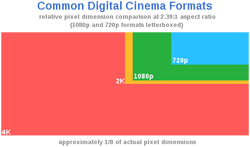The Opportunities for 4K Video Technology
 The opportunities for 4K technology — the next step forward in high resolution video — have been much hyped, particularly within the world of broadcast, though beyond digital cinema the appetite for 4K from end users remains limited. As many industry segments aim to understand the potential market impact of 4K — also known as UHD — Futuresource Consulting is announcing a free webinar on Wed., Nov. 28 to address the realities and explore the commercial and technological drivers.
The opportunities for 4K technology — the next step forward in high resolution video — have been much hyped, particularly within the world of broadcast, though beyond digital cinema the appetite for 4K from end users remains limited. As many industry segments aim to understand the potential market impact of 4K — also known as UHD — Futuresource Consulting is announcing a free webinar on Wed., Nov. 28 to address the realities and explore the commercial and technological drivers.
As many elements of the broadcast equipment market become increasingly commoditized, manufacturers continue to explore technological advancements that will capture the imagination and allow price points to be stabilized. In addition, as global demand for TV displays starts to soften, LCD TV panel and set makers are looking for the next value-add feature to kick-start a wave of consumer flat panel replacement. 3D in the home was an attempt to achieve this, and while the technology hasn’t died away, it has yet to become the solid success that many had hoped for. 4K represents a more natural progression for the industry, but one that brings its own problems.
TV Displays
For the panel makers, the issues of producing 4K panels at higher yield rates are many, while prices for commercialized sets are expected to remain out of the reach of mass market consumers for several years. Furthermore, TV makers face the task of persuading consumers to upgrade to a higher resolution set at a time when most consumers are just starting to recognize and enjoy the benefits of full HD.
Despite these barriers, Asian panel makers are moving forwards with the production of large screen 4K TVs and most major TV brands will likely launch models over the next 12 months. It remains to be seen whether 4K becomes the commercial success that those in the value chain wish for and developments over the next 12 to 18 months are likely to offer a clearer indication as to the direction the market will take.
Broadcast
Looking to the broadcast industry and pay TV, the primary challenge is the increased bandwidth required to transmit 4K. Providing four times the resolution of 1080p HD, 4K therefore demands four times the data rate. In addition, due to motion-blur being more visible at high resolution, the frame rate should ideally be doubled to counter this. This would mean the data rate would then also be doubled, hence the uncompressed data rate of 4K would be eight times that of 1080p and 16 that of 1080i.
Clearly this has implications for the compression industry and while the new High Efficiency Video Codec, HEVC, is due to be ratified in January, hardware based, real-time encoding required for live transmission is realistically at least two years away.
The Future of 4K
Futuresource Consulting is hosting a free webinar on Wed., Nov. 28 to explore the potential market impact of this next step in high resolution video. ‘Going 4K: Looking Beyond The Hype’ will draw heavily on Futuresource’s continuous program of industry and consumer research in the global broadcast, consumer electronics and entertainment content sectors, with senior members of the Futuresource team addressing the realities of 4K and the commercial and technological factors that could drive the technology forward. Find out more and book your place here.


